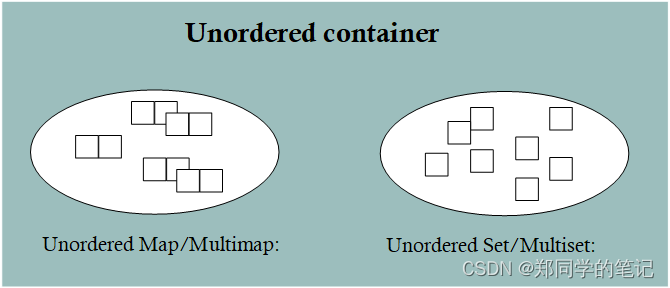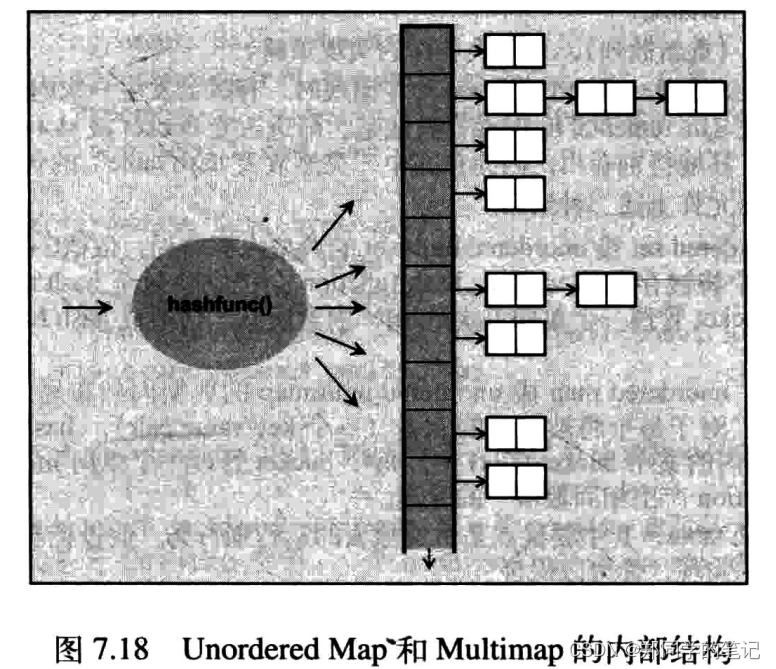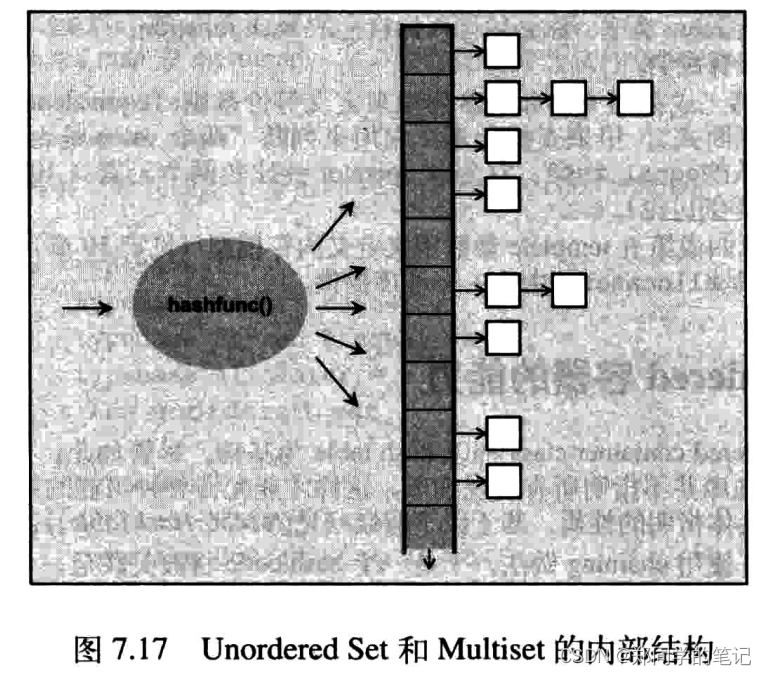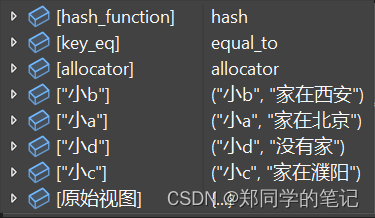【STL十一】无序容器(哈希容器)—— unordered_map、unordered_set
- 简介
除了序列式容器和关联式容器之外,C++ 11 标准库又引入了一类容器,即无序容器。无序容器,又称无序关联式容器、或者哈希容器。
和关联式容器一样,此类容器存储的也是键值对元素;不同之处在于,关联式容器默认情况下会对存储的元素做升序排序,而无序关联式容器不会。
和其它类容器相比,无序关联式容器擅长通过指定键查找对应的值,而遍历容器中存储元素的效率不如关联式容器。

一、简介
无序容器包含有 4 个具体容器,分别为 unordered_map、unordered_multimap、unordered_set 以及 unordered_multiset。
| 无序容器 | 功能 |
|---|---|
| unordered_map | 存储键值对 <key, value> 类型的元素,其中各个键值对键的值不允许重复,且该容器中存储的键值对是无序的。 |
| unordered_multimap | 和 unordered_map 唯一的区别在于,该容器允许存储多个键相同的键值对。 |
| unordered_set | 不再以键值对的形式存储数据,而是直接存储数据元素本身(当然也可以理解为,该容器存储的全部都是键 key 和值 value 相等的键值对,正因为它们相等,因此只存储 value 即可)。另外,该容器存储的元素不能重复,且容器内部存储的元素也是无序的。 |
| unordered_multiset | 和 unordered_set 唯一的区别在于,该容器允许存储值相同的元素。 |
1、关联容器和无序容器不同
和关联式容器一样,无序容器也使用键值对(pair 类型)的方式存储数据。不过,它们有本质上的不同:
- 关联式容器的底层实现采用的树存储结构,更确切的说是红黑树结构;
- 无序容器的底层实现采用的是哈希表的存储结构。
2、无序容器特点
基于底层实现采用了不同的数据结构,因此和关联式容器相比,无序容器具有以下 2 个特点:
- 无序容器内部存储的键值对是无序的,各键值对的存储位置取决于该键值对中的键,
- 和关联式容器相比,无序容器擅长通过指定键查找对应的值(平均时间复杂度为O(1));但对于使用迭代器遍历容器中存储的元素,无序容器的执行效率则不如关联式容器。
二、头文件
#include <unordered_map>
#include <unordered_set>
三、模板类
unordered_map 容器模板的定义如下所示:
template < class Key, //键值对中键的类型
class T, //键值对中值的类型
class Hash = hash<Key>, //容器内部存储键值对所用的哈希函数
class Pred = equal_to<Key>, //判断各个键值对键相同的规则
class Alloc = allocator< pair<const Key,T> > // 指定分配器对象的类型
> class unordered_map;
四、无序容器的内部结构
1、管理桶
- 每一个位置,我们把其叫做一个桶。
- 通过哈希函数映射时可能好几个值,映射到一个桶。
- 如果桶的数量小的时候,可能会出现挂篮在的现象。(即一个桶下有好几个篮子——存储的对象)。这样我们找某个值时,先找到对应的桶,然在桶里再找我们桶内存储的值。
- 管理桶:无序容器的性能依赖于哈希函数的质量和桶的数量大小
2、内部结构
中间黑色的代表桶
- unordered_map 、unordered_multimap

- unordered_set、unordered_multiset

五、unordered_map成员函数
1、迭代器
| 成员函数 | 功能 |
|---|---|
| begin() | 同array容器 |
| end() | 同array容器 |
| cbegin() | 同array容器 |
| cend() | 同array容器 |
2、元素访问
| 成员函数 | 功能 |
|---|---|
| operator[] | 同array容器 |
| at(n) | 同array容器 |
3、容量
| 成员函数 | 功能 |
|---|---|
| size() | 同array容器 |
| max_size() | 同array容器 |
| empty() | 同array容器 |
4、修改操作
| 成员函数 | 功能 |
|---|---|
| clear() | 同vector容器 |
| insert() | 同vector容器 |
| insert_or_assign(C++17) | 同map容器 |
| emplace() | 同vector容器 |
| emplace_hint() | 同map容器 |
| try_emplace(C++17) | 同map容器 |
| erase() | 同vector容器 |
| swap() | 同vector容器 |
| extract(C++17) | 从另一容器释出结点 |
| merge(C++17) | 从另一容器接合结点 |
5、操作
5、查找
| 成员函数 | 功能 |
|---|---|
| count(key) | 同map容器 |
| find(key) | 同map容器 |
| contains (C++20) | 同map容器 |
| equal_range(key) | 同map容器 |
6、桶接口
| 成员函数 | 功能 |
|---|---|
| begin() | 同array容器 |
| end() | 同array容器 |
| cbegin() | 同array容器 |
| cend() | 同array容器 |
| bucket_count | 正在使用的桶的数目。 |
| max_bucket_count() | 容器容纳的最多的桶的数量 |
| bucket_size(n) | 第n个桶中有多少个元素 |
| bucket(key) | 关键字为k的元素在哪个桶种 |
7、哈希策略
| 成员函数 | 功能 |
|---|---|
| load_factor | 每个桶的平均元素数量,返回float值 |
| max_load_factor | 试图维护的平均桶大小,返回float值,会在需要时添加新的桶,以使得load_facotr < max_load_factor |
| rehash(n) | 重组存储,使得bucket_count >=n, 且bucket_count > size/max_load_factor |
| reserve(n) | 重组存储,使得可以保存n个元素且不必rehash。 |
六、demo
1、构造函数、emplace、find、迭代器
- 返回值
指向键等于 key 的元素的迭代器。若找不到这种元素,则返回尾后(见 end() )迭代器。
#include <iostream>
#include <string> // string
#include<unordered_map>
using namespace std;
int main() {
// 调用构造函数 1,也就是默认构造函数
unordered_map <string, string> umap{
{
"小b","家在西安"},
{
"小a","家在北京"},
{
"小d","没有家"},
};
umap.emplace("小c","家在濮阳" );
cout << "i can find 小c:" << endl;
auto ite = umap.find("小c");
cout << ite->first << "=" << ite->second << endl << endl;
//使用迭代器输出 umap 容器存储的所有键值对
for (auto iter = umap.begin(); iter != umap.end(); ++iter) {
cout << iter->first << " " << iter->second << endl;
}
return 0;
}
输出
i can find 小c:
小c=家在濮阳
小b 家在西安
小a 家在北京
小d 没有家
小c 家在濮阳
2、桶接口bucket_count、max_bucket_count、bucket_size、bucket
#include <iostream>
#include <string> // string
#include<unordered_map>
using namespace std;
int main() {
// 调用构造函数 1,也就是默认构造函数
unordered_map <string, string> umap{
{
"小b","家在西安"},
{
"小c","家在濮阳"},
{
"小a","家在北京"},
{
"小d","没有家"},
};
//获取键为 小c的键值对所在的范围
auto pair = umap.equal_range("小c");
//输出 pair 范围内的每个键值对的键的值
for (auto iter = pair.first; iter != pair.second; ++iter) {
cout << iter->first << "="<<iter->second;
}
cout << endl;
auto bc = umap.bucket_count();
cout << "bucket_count = " << bc << endl;
auto bcm = umap.max_bucket_count();
cout << "max_bucket_count = " << bcm << endl;
auto szie = umap.bucket_size(3);
cout << "bucket_size(3) = " << szie << endl;
auto pos = umap.bucket("小c");
cout << "bucket(\"小c\") = " << pos << endl;
return 0;
}
输出
小c=家在濮阳
bucket_count = 8
max_bucket_count = 1152921504606846975
bucket_size(3) = 1
bucket(“小c”) = 3
七、unordered_multimap
和 unordered_map 容器一样,unordered_multimap 容器也以键值对的形式存储数据,且底层也采用哈希表结构存储各个键值对。两者唯一的不同之处在于,unordered_multimap 容器可以存储多个键相等的键值对,而 unordered_map 容器不行。
无序容器中存储的各个键值对,都会哈希存到各个桶(本质为链表)中。而对于 unordered_multimap 容器来说,其存储的所有键值对中,键相等的键值对会被哈希到同一个桶中存储。
- unordered_multimap 容器模板的定义如下所示:
template < class Key, //键(key)的类型
class T, //值(value)的类型
class Hash = hash<Key>, //底层存储键值对时采用的哈希函数
class Pred = equal_to<Key>, //判断各个键值对的键相等的规则
class Alloc = allocator< pair<const Key,T> > // 指定分配器对象的类型
> class unordered_multimap;
- demo
#include <iostream>
#include <string> // string
#include<unordered_map>
using namespace std;
int main() {
// 调用构造函数 1,也就是默认构造函数
unordered_multimap <string, string> ummap{
{
"小b","家在西安"},
{
"小c","家在濮阳"},
{
"小a","家在北京"},
{
"小d","没有家"},
{
"小d","也没有家"},
};
//输出 ummap容器中存储键为 'b' 的键值对的数量
cout << ummap.count("小d") << endl;
for (auto iter = ummap.begin(); iter != ummap.end(); ++iter) {
cout << iter->first << " " << iter->second << endl;
cout << "ummap.bucket(iter->first) = " << ummap.bucket(iter->first)<<endl;
}
cout << "ummap.bucket_count() = " << ummap.bucket_count();
return 0;
}
- 输出
2
小b 家在西安
ummap.bucket(iter->first) = 0
小c 家在濮阳
ummap.bucket(iter->first) = 3
小a 家在北京
ummap.bucket(iter->first) = 1
小d 没有家
ummap.bucket(iter->first) = 2
小d 也没有家
ummap.bucket(iter->first) = 2
ummap.bucket_count() = 8
八、unordered_set
unordered_set 容器具有以下几个特性:
- 不再以键值对的形式存储数据,而是直接存储数据的值;
- 容器内部存储的各个元素的值都互不相等,且不能被修改。
- 不会对内部存储的数据进行排序(这和该容器底层采用哈希表结构存储数据有关,可阅读《C++ STL无序容器底层实现原理》一文做详细了解);
对于 unordered_set 容器不以键值对的形式存储数据,读者也可以这样认为,即 unordered_set 存储的都是键和值相等的键值对,为了节省存储空间,该类容器在实际存储时选择只存储每个键值对的值。
- unordered_set 容器的类模板定义如下:
template < class Key, //容器中存储元素的类型
class Hash = hash<Key>, //确定元素存储位置所用的哈希函数
class Pred = equal_to<Key>, //判断各个元素是否相等所用的函数
class Alloc = allocator<Key> //指定分配器对象的类型
> class unordered_set;
- demo
#include <iostream>
#include <string> // string
#include<unordered_set>
using namespace std;
int main() {
unordered_set<string> uset{
"小b",
"小c",
"小a",
"小d",
};
auto ite = uset.insert("小e");
cout << *(ite.first) << " " << ite.second << endl;
unordered_set<string> set2;
set2.insert(uset.begin(), uset.end());
for (auto iter = set2.begin(); iter != set2.end(); ++iter) {
cout << *iter << endl;
}
return 0;
}
- 输出
小e 1
小b
小c
小a
小d
小e
九、unordered_multiset。
unordered_multiset 容器大部分的特性都和 unordered_set 容器相同,包括:
- unordered_multiset 不以键值对的形式存储数据,而是直接存储数据的值;
- 该类型容器底层采用的也是哈希表存储结构,它不会对内部存储的数据进行排序;
- unordered_multiset 容器内部存储的元素,其值不能被修改。
和 unordered_set 容器不同的是,unordered_multiset 容器可以同时存储多个值相同的元素,且这些元素会存储到哈希表中同一个桶(本质就是链表)上。
读者可以这样认为,unordered_multiset 除了能存储相同值的元素外,它和 unordered_set 容器完全相同。
- unordered_multiset 容器类模板的定义如下:
template < class Key, //容器中存储元素的类型
class Hash = hash<Key>, //确定元素存储位置所用的哈希函数
class Pred = equal_to<Key>, //判断各个元素是否相等所用的函数
class Alloc = allocator<Key> //指定分配器对象的类型
> class unordered_multiset;
- demo
#include <iostream>
#include <unordered_set>
using namespace std;
int main() {
std::unordered_multiset<int> umset{
1,2,2,2,3,4,5 };
cout << "multiset size = " << umset.size() << endl;
cout << "multiset count(2) =" << umset.count(2) << endl;
//删除容器中所有值为 2 的元素
int num = umset.erase(2);
cout << "删除了 " << num << " 个元素 2" << endl;
//输出容器中存储的所有元素
for (auto iter = umset.begin(); iter != umset.end(); ++iter) {
cout << *iter << " ";
}
cout << "umset.bucket_count() = "<< umset.bucket_count();
return 0;
}
- 输出
multiset size = 7
multiset count(2) =3
删除了 3 个元素 2
1 3 4 5 umset.bucket_count() = 8
参考:
1、C++ STL 容器库 中文文档
2、STL教程:C++ STL快速入门
3、https://www.apiref.com/cpp-zh/cpp/header.html
4、https://en.cppreference.com/w/cpp/container
